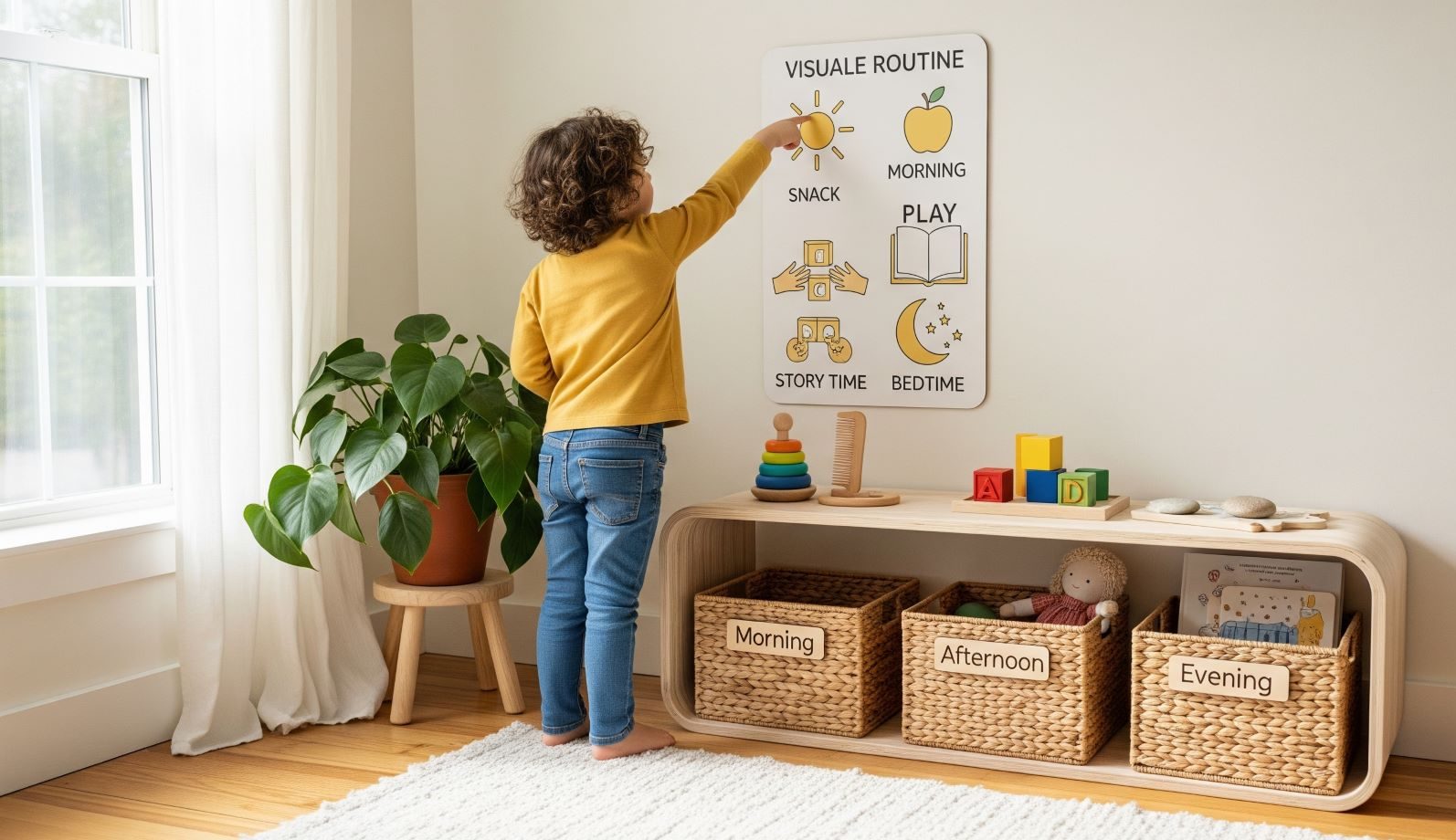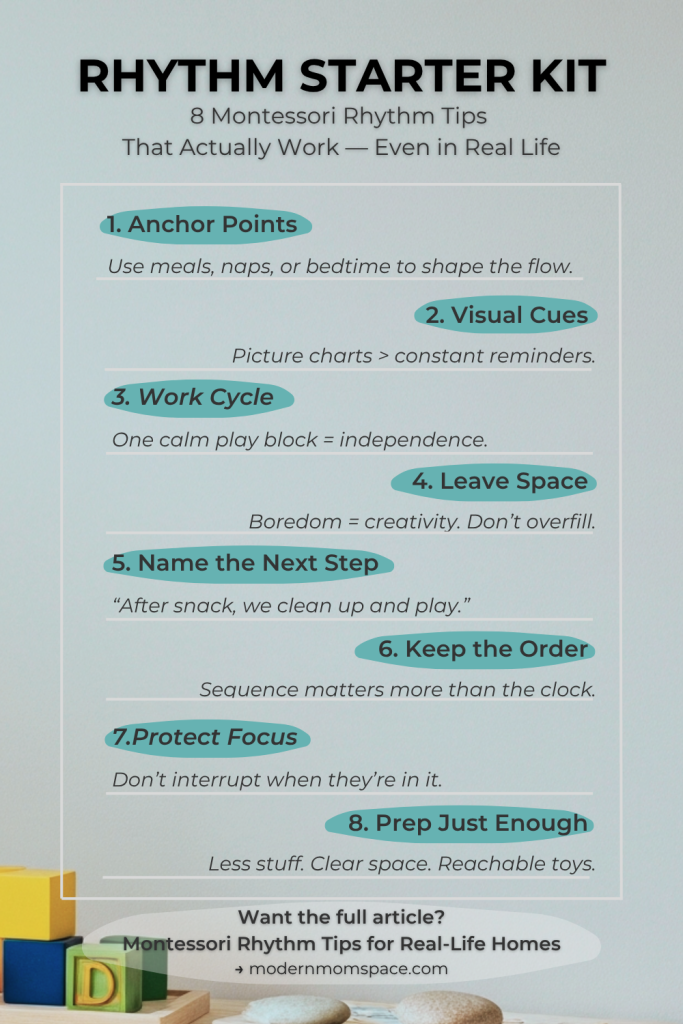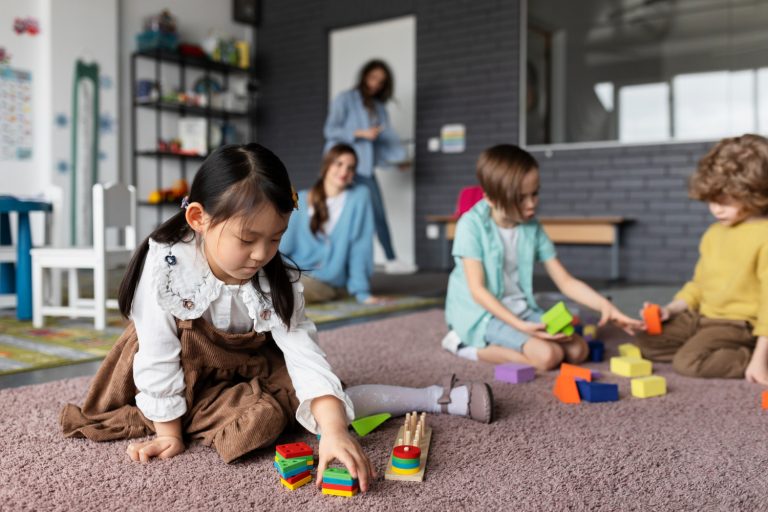Montessori Rhythm Tips for Real-Life Homes
Forget rigid schedules. Let’s talk about calm, predictable flow that actually works in your messy, modern life.
You set up the shelf. You bought the toys.
But your “Montessori rhythm” still feels like chaos.
If you’re trying to bring structure into your home the Montessori way—but your mornings still run late and your toddler melts down by 4 PM—you’re not doing it wrong.
You just need rhythm that actually works in real life.
Spoiler: You don’t need to overhaul your life.
You need a flow your kid can actually feel — not a checklist you’re constantly chasing.
What Is a Montessori Rhythm—Really?
Here’s what it’s not: It’s not a military-style schedule.
It’s not about having the perfect shelf layout or controlling every minute of your child’s day.
A Montessori rhythm is simply a predictable daily flow—a pattern your child can rely on. It emphasizes:
Maria Montessori believed that children thrive on repetition and order—but not the kind that comes from timers and to-do lists. Rhythm is more about the sequence than the schedule.
Think of it like music:
A rhythm you feel—not a clock you obey.
You might wake up at 6:45 one day and 7:15 the next, but the flow—get dressed, breakfast, quiet activity—stays the same. That’s what builds security, independence, and calm.
The rhythm isn’t in your furniture. It’s in your flow.
Why Most Parents Struggle With Rhythm at Home

Let’s be honest: most parenting advice about routines is either too idealistic or way too rigid. Montessori rhythm sounds good in theory—but real life doesn’t always cooperate.
Here’s why most parents get stuck:
1. Life Isn’t Predictable—Especially with Kids
Maybe your toddler skipped nap again.
Maybe your preschooler had a meltdown over the blue cup.
Maybe your baby finally fell asleep and then the delivery guy rang the bell.
A perfectly timed day? Not gonna happen. And trying to force it usually leads to more frustration—for both of you.
2. Your Kid Resists Every Transition
Ever try to take a screen away?
Or ask your kid to leave the playground?
Or convince them to brush their teeth when they’re mid-pretend-play?
Montessori rhythm is supposed to reduce power struggles. But if transitions are chaotic or you’re constantly repeating yourself, it feels like it’s not working.
The missing piece? A rhythm your child can anticipate without being told every step.
3. You’re the Human Clock—and It’s Exhausting
Many parents end up micromanaging the day:
“Time to eat.”
“Now clean up.”
“Five more minutes.”
“No, not that drawer.”
Montessori encourages independence—but most homes don’t have the systems in place to support it. So instead of rhythm, you get constant supervision. That’s burnout, fast.
4. You Think You’re Failing Because Instagram Says So
You scroll past posts with perfect shelves, wooden toys, a toddler calmly peeling a banana alone at 7:15 AM.
And your house?
Sticky counters.
Toy clutter.
And a child who just bit their sibling because it was “their turn to push the stool.”
Online, Montessori looks peaceful and perfect. In reality, rhythm is messy, flexible, and deeply personal. What works for someone else might not work for you—and that’s okay.
5. You Already Have Routines—But They’re Not Helping
Most families have some routine:
Wake up → breakfast → school → chaos → bedtime.
But it often feels reactive—like the day’s running you. Not the other way around.
A Montessori rhythm shifts that. It’s not just about “what time is lunch?” It’s about what happens next, and helping your child move through the day with confidence and clarity.
This isn’t about doing more.
It’s about doing less—more predictably.
Montessori Rhythm Building Blocks That Actually Work

You don’t need a full home overhaul to build a better rhythm.
You just need a few core habits that take the pressure off you—and give your child the predictability they crave.
Here’s what works, even in messy, loud, non-Instagram homes:
1. Anchor Points First
Start with what’s already fixed: wake-up, meals, naps, bedtime. These become your anchors.
Don’t build the whole day. Build around these key moments.
Example:
Same flow. Flexible times.
2. Use Visual Cues, Not Constant Reminders
Instead of repeating “Clean up your toys!” or “Time to brush teeth!” 47 times a day…
Use:
Montessori homes are prepared environments. That means your home should guide your child—not just your voice.
3. Focus Time = Work Cycle (Even at Home)
In Montessori classrooms, the work cycle is a 2–3 hour window where kids choose and complete activities without interruption.
At home, try 30–60 minutes of focused, independent play.
Doesn’t have to be academic. Just uninterrupted.
Your job?
Set the stage and back off.
Tip: If your kid struggles with this, start small. Try 10–15 minutes and build from there.
4. Leave Room for Boredom
Stop overscheduling. Stop jumping in to entertain. Let them get bored.
That pause between activities? That’s where creativity lives.
Montessori rhythm isn’t meant to fill every minute. It creates space for exploration and self-direction.
5. Name What Comes Next
Kids don’t know the flow unless you tell them repeatedly.
Say it out loud:
“After snack, we clean up and go outside.”
“Once we’re dressed, it’s puzzle time.”
Eventually, they’ll say it before you do.
6. Keep the Order, Flex the Time
This is key: if today’s nap is at 1:15 instead of 12:45—no big deal. What matters is the sequence.
Why it works: Kids feel safe when they know what comes next, even if the timing changes.
7. Protect the Calm Blocks
When your child is focused—don’t interrupt.
Don’t squeeze in errands or tasks. Let the rhythm breathe.
Interrupting a focused child is like unplugging your phone mid-charge.
8. Prep Just Enough
You don’t need the perfect shelf. But you do need:
The more the environment supports independence, the smoother your rhythm becomes.
You don’t need a rigid schedule.
You need a reliable flow your child can count on.

Real-Life Examples from Real Homes
No two Montessori homes look the same. And that’s the point.
Rhythm isn’t a formula. It’s a custom-fit flow that works with your family’s needs—not against them.
Here are a few snapshots from real parents using Montessori rhythm in real-life homes:
Working Mom, Toddler + Preschooler
“I work full-time and my kids go to daycare, so I focus on rhythm in the mornings and evenings. We keep the flow the same: wake, dress, eat, play. After dinner, it’s always quiet play → bath → books → bed. My kids know the order, even if the timing shifts. It’s made our evenings so much calmer.”
Why it works:
Consistency doesn’t have to cover the whole day. A simple, predictable evening rhythm reduces power struggles and bedtime chaos.
Toddler + Baby at Home
“My rhythm is super simple. We center the day around nap. Mornings are: eat, play, go outside. After lunch, it’s nap or quiet time. Afternoons are flexible but always end with books. No timers, no battles—just a flow they can count on.”
Why it works:
Anchoring to naps and mealtimes creates natural structure without overplanning.
Rhythm with Screen Time? Yep.
“We use screens during our rhythm on purpose. For example: outdoor play → snack → 20 mins of a nature documentary → then quiet shelf time. It’s not a free-for-all. It’s part of the flow.”
Why it works:
When screens have a place in the rhythm—not used as filler—it reduces begging, bargaining, and random screen spirals.
Neurodivergent Kids
“We use a visual schedule with icons for each step of our daily rhythm. My son checks off each one as we go. It helps him see the flow instead of guessing. He transitions better and feels more in control.”
Why it works:
Visual cues + predictable sequences = less anxiety and smoother transitions for many kids, especially those with sensory or processing differences.
Your rhythm doesn’t have to be long.
Or fancy.
Or quiet.
It just has to be yours.
The Key Mindset Shift: Don’t Chase Perfect. Chase Predictable.
Montessori rhythm isn’t about crafting the “ideal day.” It’s about creating a reliable one.
Too many parents give up because the day didn’t go perfectly:
That’s not failure. That’s parenting.
The point of rhythm isn’t to control the chaos—it’s to give your child a structure they can depend on, even when things fall apart for a bit.
Montessori rhythm gives your child:
And it gives you:
Start small. Anchor two parts of the day.
Then build from there.
You’re not behind. You’re building something that actually works—for your home.
Save it. Share it. Send it.
Found this helpful? Save this article. Share it with your mom group.
Or send it to the parent in your life who’s stuck in survival mode and just needs a rhythm that feels doable.









